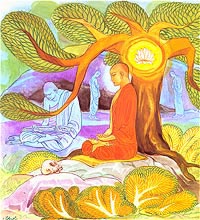LESSON 3231 Fri 3 Jan 2020
from
KUSHINARA NIBBANA BHUMI PAGODA -PATH TO ATTAIN PEACE and ETERNAL BLISS AS FINAL GOAL
Buddhist Doctrines - What is Nibbana? - The Roots of Nibbana
First Thank everyone who made Smile You this year. Your are one of them!
Wish you all a very Happy New Year!
May you all be Very Happy, Well and Secure!
May you all LIVE Long!
May you all be Very Happy, Well and Secure!
May you all have calm, quiet, alert, attentive and an equanimity Mind with a clear understanding that everything is changing!
https://www.ffmt.fr/articles/anapanasati/jhanas/ab.jhanas.pdf
THE FOURTH JHANA
Sukha has vanished! As the stillness of the knower calms that which is known, the bliss that was the central feature of the first three jhanas changes again when one enters the fourth jhana. Only this time it changes more radically. Sukha completely disappears. It vanishes.What one is left with is an absolute still knower seeing absolute stillness.
The perfection of Peace. From the perspective of the fourth jhana, the bliss of the previous jhanas is seen as a residual movement of the mental object, and an affliction obscuring something much greater. When the bliss subsides, all that is left is the profound peace that is the hallmark of the fourth jhana. Nothing moves in here, nothing glows. Nothing feels happiness or its opposite, discomfort. One feels perfect balance in the very center of the mind. Like being in the center of the cyclone, nothing stirs in the center of the mind’s eye. There is a sense of perfection inhere, a perfection of stillness and a perfection of awareness. The Buddha described it as the purification of mindfulness, just looking on (upekkhasati parisuddhim) (e.g. DN 9.13).
The peace of the fourth jhana is like no other peace to be found in the world. It can only be known having passed through the experience of the previous three jhanas. That passage is he only way of later confirming that he unmoving peace that one felt, was indeed that of fourth jhana.Furthermore, the state of fourth jhana is so very still, that one remains on its plateau for many hours. It seems impossible that one could experience the fourth jhana for any less time.
Though piti and sukha have both ceased in the fourth jhana, and all that is left is the perfection of peace, such an experience is later recognized,on reviewing, as supremely delightful. Although all bliss has vanished,the perfect peace of the fourth jhana is seen as the best bliss so far. It isthe bliss of no more bliss! And this is not playing with words, trying to sound clever and mystical. This is how it is.
Summary of the Fourth Jhana
This the fourth jhana has the following features:
1.The disappearance of sukha
2.An extremely long lasting, and unchanging, perception of the perfection of peace, reached through the lower three jhanas;
3.The same absolute rock-like stillness, and absence of a doer, as in the second and third jhanas;
4.The complete inaccessibility from the world of the five senses and one’s body.
THE BUDDHA’S SIMILE FOR THE FOUR JHANAS
The Buddha would often describe the experience within the four jhanas using an evocative simile for each (MN 39.15-18, MN 77.25-28, etc.).Before explaining these similes, it is helpful to pause to clarify the meaning of a key word used in all the similes, kaya. Kaya has the same range of meanings as the English word “body.” Just as “body” can meanthings other than the body of a person, such as a “body of evidence” for example, so too the Pali word kaya can mean things other than aphysical body, such as a body of mental factors, nama kaya. (DN 15.20).In the jhanas, the five senses aren’t operating, meaning that there is no experience of a physical body. The body has been transcended.Therefore, when the Buddha states in these four similes “…so that there is no part of his whole kaya un-pervaded (by bliss etc.),” this can betaken to mean “…so that there is no part of his whole mental body of experience un-pervaded (by bliss etc.)” (MN 39.16). This point is too often misunderstood.
Buddha’s simile for the first jhana was a ball of clay (used as
soap)with just the right amount of moisture, neither too dry nor leaking
out.The ball of clay stands for the unified mind, wherein mindfulness
has been restricted to the very small areas created by the “wobble.”
The moisture stands for the bliss caused by total seclusion from the
world ofthe fives senses. The moisture pervading the clay ball
completely indicates the bliss thoroughly pervading the space and
duration of themental experience. This is later recognized as bliss
followed by bliss, and then more bliss, without interruption. The
moisture not leaking outdescribes the bliss always being contained in
the space generated by the wobble, never leaking out of this area of
mind space into the world of thefive senses, as long as the jhana
persists.


https://www.youtube.com/watch?v=0W8zR212IUI
Spring water from the side of my hill!! FRESH CLEAN WATER!
PowerModz
159K subscribers
Thanks for watching more great videos to come!To help out PowerModz via PayPal please go here! https://www.paypal.me/powermodzcom
For PowerModz clothing and hats please go here! http://shop.powermodz.com/powermodzlo…
For PowerModz clothing and hats please go here! http://shop.powermodz.com/powermodzlo…
Category
Autos & Vehicles

Spring water from the side of my hill!! FRESH CLEAN WATER!
159K subscribers
https://www.youtube.com/watch?v=T30ZNQ4moHM
Hawaiian Water Lily Meditative Video
Bob Nisbet
652 subscribers
A meditative video of water lilies and other flowers from a Hawaiian
garden. Video by Bob Nisbet with music by George P. Tingley. I recently
found out that these are not lotus flowers, but water lilies.
Category
Entertainment
meditative video of water lilies and other flowers from a Hawaiian
garden. Video by Bob Nisbet with music by George P. Tingley. I recently
found out that t…
The fourth jhana is likened to a man draped from head to toe in a clean white cloth. The man represents the mind. The clean white cloth represents the perfect purity of both equanimity and mindfulness that is the hallmark of the fourth jhana. The mind in the fourth jhana is stainless, spotless as clean cloth, perfectly still and just looking on,purely and simply. Of course, this absolute purity of peacefulness pervades the whole body of the mental experience, from the start to the end just as the white cloth completely covers the man’s body, form head to toe.
This is the meaning to the four similes for jhana, as I understand them.
https://giphy.com/gifs/adweek-magic-mike-mr-clean-26gscNQHswYio5RBu

MOVING FROM JHANA TO JHANA
As I’ve indicated before, when one is in any jhana, one cannot make amove. One cannot formulate any decision to proceed from this jhana tothat. One cannot even make a decision to come out. All such control has been abandoned within jhana. Furthermore, the ultra-stillness of mindfulness in jhana freezes the activity of mind called comprehension to the extent that, while in jhana, one can hardly make sense of one’s experience. The landmarks of jhana are only recognized later, afteremerging and reviewing. This, within any jhana, not only one cannotmove, but also one cannot know where one is nor where to move to! Sohow does movement from jhana to jhana occur?
A Four-Roomed House. Imagine a four-roomed house with only one entrance door. Going through that door, one-enters the first room. One must go through the first room to enter the second room, go through the second room to enter the third room, and one must go through the third room to enter the fourth room. The to go out from the fourth room one must leave via the third room, to go out from the third room one must leave via the second room, to out from the second room one must leave via the first room, and to go out from the first room one must leave bythe same door through which one came in. Now suppose that the floorsurface in all the four rooms was so slippery that it is impossible to add to the momentum within the house. Thus, if one entered the house withonly a little momentum, one will slide to a halt within the first room.With a great amount of entry momentum, one may come to a stop in thesecond, or even the third room. Then with yet more entry momentum,one may reach the fourth room.
Such a simile well describes how moving from jhana to jhana actually occurs. Within a jhana there is no control, like the very slippery floor inside the house that make adding to the momentum impossible. If oneenters the doorway into jhanas with a little momentum, one stops in the first jhana. With greater momentum, one reaches the second or third jhana. And, with yet more entry momentum, one may reach the fourth jhana. The entry momentum can only be generated outside of jhana,when control is possible. The type of “momentum” referred to her isthe momentum of letting go.
Letting Go is Cultivated Before Entering Jhana. Letting go is cultivated before entering jhana, to the point where it becomes an involuntary inclination of the mind, a strong natural tendency. If one enters the doorway into the jhanas with little more than adequate “letting go momentum,” one will stop in the first jhana. With a stronger automatic tendency to let go, one reaches the second jhana or thirdjhana. With a very strong inclination to letting go, one attains to thefourth jhana. However, one cannot increase the strength of letting go momentum while inside the jhanas. Whatever one enters with is all that one has.
Reviewing the Experience of Bliss. One can cultivate this momentum of letting go outside of jhana by reviewing the experiences of bliss and by recognizing the obstacles called attachments. When the mind recognizes how superior is the happiness in states of letting go, the inclination to more letting go grows ever stronger. Sometimes I have taught mystubborn mind by thinking, “See mind! See! See how much more bliss isin the states of letting go! See mind! Don’t forget mind! Remember,okay?” The mind then leans ever more strongly to letting go. Or the mind can recognize the obstacles to deeper bliss, being the various levels of attachment that block letting go, and these hinder more bliss. When the mind learns, through reviewing, to recognize the enemies to its own happiness—the attachments—then its inclination to letting go becomes empowered by wisdom. This is how one can cultivate the momentum of letting go outside of jhana, so that one may enter the jhana with greatletting go and reach the deeper jhanas.
Each Jhana is Within the Other Another way to look at how one moves from jhana to jhana is with the simile of the thousand-petalled lotus. The petals on a thousand-petalled lotus open up in order, in strict succession, only after being warmed by the sun. The first jhana can be compared to the rare and delicate 993rd row of petals. Just as the 993rd row of petals, now being warmed by the sun, holds and conceals within the even more fragrant 994th row of petals, so to the rare and delicate first jhana, now being warmed byletting go, holds and conceals within it the even more blissful second jhana. When this 993rd row of petals eventually opens up, then the 994th row of petals appears in its center. In the same way, when first jhana eventually opens up, then the second jhana appears in its center. Thus the second jhana is actually within the First jhana, the third jhana within the second jhana, and the fourth jhana within the third jhana.
To put it another way, in the simile of the four-roomed house, the rooms are concentric. Thus one does not come out from the first jhana to gonext to the second jhana. Instead, one goes deeper into the first jhana tointo the second jhana, deeper into the second jhana to get to the third jhana, and deeper in to the third jhana to enter the fourth jhana. Thenext level of jhana always lies within the present jhana.
The Power of Aditthana When one has had much experience of jhana, one can move from jhanato jhana using the power of Aditthana. In this context, the Pali word Aditthana represents the Buddhist way of programming the mind. At thebeginning of one’s meditation, one can program the mind to enter aspecified jhana for a pre-determined length of time. Of course, this only works for one who is very familiar with the destination and is well acquainted with the rout there. This is the method that every accomplished meditators use. It is like setting the automatic pilotshortly after take off. However, even for such accomplished meditators,the specified jhana is reached by traversing the same path. For example,if one programs the mind to enter the third jhana, then it must passthrough the first jhana and then pass through the second jhana to enter the third jhana, although it may pass through these lower jhanas quickly.
THE IMMATERIAL ATTAINMENTS
In the simile of the thousand petalled lotus cited above, the 993rd row ofpetals represents the first jhana, the 994th row the second jhana, the 995th and 996th rows of petals should represent the third and fourth jhanas. However, you may be wondering what do the 997th, 998th, 999thand 1,000th rows of petals represent?
Beyond the four jhanas lies the four immaterial attainments. It is noteworthy that the Buddha never called these attainments jhana in the suttas. Only the commentaries, compiled a thousand years later, callthem jhana.
The Four Immaterial Attainments are:
1.The mind-base of unlimited space;
2.The mind-base of unlimited consciousness;
3.The mind-base of nothingness;
4.The mind-base of neither-perception-nor-non-perception.
Just as the fourth jhana lies within the third jhana, so the first immaterial attainment lies within the fourth jhana, the second immaterial attainment lies within the first immaterial attainment and soon like the rows of petals of the lotus. Thus, of necessity, all four immaterial attainments possess the following features carried over from the jhanas.
1.The mind remains inaccessible to the world of the five senses and all knowledge of the body;
2.The mind persists in rock-like stillness, incapable of forming any thought or making any plans, for long periods of time;
3. Comprehension is so frozen that one can hardly make sense, at the time of one’s experience. Comprehension is achieved after emerging; and
4.The pure equanimity and mindfulness of the fourth jhana remains as a foundation for each immaterial attainment.
Just as the first three jhanas take different forms of bliss as their object,and the fourth jhana takes a sublime state of pure peace as its object, so the immaterial attainments each take a pure mental object. The perceptions of these objects I call “mind-bases,” since they are the mental platforms on which the immaterial attainments rest. These unmoving mind-bases get ever more refined, and empty, the higher the immaterial attainment.
For example, when a meditator in the early stages becomes perfectly focused in the present moment, one-pointed in time, ordinary concepts of time are squeezed out, and other unworldly perceptions of time replace them. When one is fully centered within the present moment, on the one had it feels timeless and on the other hand it feels as if one has all the time in the world. Within the point of absolute now, time is without edges, undefined and immeasurable. It is infinite and nothing at the same time. It is unlimited (anatta), The experience of one-pointedness in time, seen early in the meditation, can be the key to understanding the simultaneous sense of infinity and emptiness in the more profound states of one-pointedness called the immaterial attainments.
From the fourth jhana, the mind can look into the perfect peace to perceive absolute one-pointedness in space. This is one of the features of the fourth jhana always available for inspection, as it were, and it is the doorway into the immaterial attainments. In this absolute one-pointedness, space it perceived as both infinite and empty, a sort of no-space. Because it is perceived as empty of that which usually limits space, material form (rupa), this attainment and those following are called immaterial (arupa) attainments.
The Mind-Base of Unlimited Space
The first immaterial attainment, then, is the mind-base of unlimitedspace, perceived as both infinite and empty, immeasurable and undefined. This is the perception that fills the mind thoroughly and persists without blinking for the long duration of the attainment.Mindfulness, powerful, still and purified, looks on at this perception with utter contentment.
The Mind-Base of Unlimited Consciousness
Within the perception of unlimited space lies the perception of no-space,of space losing its meaning. When the mind attends to this feature within the first immaterial attainment, space disappears and is replaced by perception of absolute one-pointedness of consciousness. Asindicated above by the common experience of one-pointedness of time, inthe state that perceives one-pointedness of consciousness, consciousness simultaneously feels infinite and empty, immeasurable and undefined.One has entered the second immaterial attainment of the mind-base of unlimited consciousness. This is the perception that fills the mind completely and persists without wavering for even longer periods of time.
The Mind-Base of Nothingness
Within the perception of unlimited consciousness lies the perception of no-consciousness, of consciousness now losing it meaning as well.When the mind focuses on this feature within the second immaterial attainment, all perception of consciousness disappears. Perceptions ofmaterial form and space have already disappeared, and so all that one isleft with is the one-pointedness of nothingness. One has entered the third immaterial attainment of the mind-base of nothingness. This is the concept that fills the mind totally, persisting unchanged for yet longer periods of time.
The Mind-Base of Neither-Perception-Nor-Non-Perception.
Within the perception of nothingness lies the perception of not even nothing! If the mind is subtle enough to see this feature, then theperception of nothingness disappears and is replaced by the perception
of neither perception nor no perception. All that one can say about
this
fourth immaterial attainment is that it is, in fact, a perception (AN9s,42). In the simile of the thousand petalled lotus, this state isrepresented by the 1,000th layer of petals, still closed, with all the 999other layers of petals fully open. The 1000th petal is almost a non-petal,being the most subtle and sublime of all. For it clasps within its gossamer fabric the famous “Jewel in the heart of the lotus,” Nibbana.
NIBBANA, THE END OF ALL PERCEPTION
For within the perception of neither perception of neither perception nor non-perception lies the end of all perception, the cessation of all that isfelt or perceived, Nibbana. If the mind attends to this, the mind stops.When the mind starts again one gains the attainment of Arahant oranagami, these are the only possibilities.
The Sequence of Gradual Cessation
Another way of viewing the jhanas and the four immaterial attainments is by placing them in the sequence of gradual cessation. The process that leads into the first jhana is the cessation of the world of the five senses together with the body and all doing. The path from the first jhana to the fourth jhana is the cessation of that part of the mind that recognizes pleasure and displeasure. The road from the fourth jhana tothe fourth immaterial attainment is the cessation, almost, of theremaining activity of the mind called “knowing.” And the last step is the cessation of the last vestige of knowing. Through jhanas and immaterial attainments, first one lets go of the body and the world, of the fivesenses. Then one lets go of the doer. Then one lets go of pleasure and displeasure. The one lets go of space and consciousness. Then one lets go all knowing. When one lets go of an object, the object disappears,ceases. It is remains one hasn’t let go. Through letting go of allknowing, knowing ceases. This is the cessation of everything,including the mind. This is the place where consciousness no longer manifests, where earth, water, fire and air find no footing, where name-and-form are wholly destroyed, (DN 11,85). Emptiness. Cessation.Nibbana . The “jewel” in the heart of the lotus.
FINAL WORDS
In this part on the jhanas, I have led you on a journey from theory through to practice up to the high mountain ranges where lie the great summits that are the jhanas, and up higher to the rarefied peaks thatare the immaterial attainments. Though the tour may seem way beyond you today, tomorrow you may find yourself well on the rout. So it is helpful even today to have this road map before you.
Moreover, these jhanas are like immensely rich gold mines, but carrying the most precious of insights rather than one of the most precious metals. They supply the raw materials, the unexpected data, which build those special insights that open one’s eyes to Nibbana. The jhanas are jewels that adorn the face of Buddhism. Moreover, not only are they essential to the experience of Awakenment with Awarenes, they are possible today.
I conclude this part with the words of the Lord Buddha:
Natthi Jhanam Apannassa There is no jhana without wisdom
Panna Natthi Ajhayato There is no wisdom without jhana
Yamhi Jhanan Ca Panna ca But for one with both jhana and wisdom
Sa Ve Nibbana Santike They are in the presence of Nibbana-Dhp 373
 |
Verse 373. He Who Is Calm Experiences Transcendental Joy
Explanation: A monk who enters an empty house, whose mind |
1 Although sound can disturb the first jhana, the fact is that when one perceives the sound, one is no longer in jhana.
VOICE of ALL ABORIGINAL AWAKENED SOCIETIES (VoAAAS)
| 2. Does India really need an NPR when there’s Census? | ||
 |
|
With states like Punjab, West Bengal, Chhattisgarh, Kerala and Madhya Pradesh halting the groundwork needed for conducting the National Population Register
(NPR) survey — scheduled from April 1 to September 30 — the controversy regarding its utility in creation of a National Register of Citizens (NRC), has heightened, despite PM Narendra Modi denying any such plans. Which begs the question: Given that there will be a Census next year, does the government really need to spend an additional Rs 3,941 crore — on top of the Rs 8,754 crore for Census — for conducting the NPR data collection exercise?
|
https://www.huffingtonpost.in/entry/economic-slowdown-indian-economy-onion-prices-nirmala-sitharaman-stagflation_in_5e048271e4b0843d360362dd??ncid=newsltinhpmgnews
https://www.huffingtonpost.in/…/economic-slowdown-indian-ec…
1) These slaves, stooges, chamchas, chelas, bootlickers, own mother’s
flesh eaters of just 0.1% intolerant, violent, militant, number one
terrorists of the world, ever shooting, mob lynching, lunatic, mentally
retarded FOREIGNERS from BENE ISRAEL chitpavan brahmins of
Rowdy/Rakshasa Swayam Sevaks (RSS) after gobbling the Master Key through
Murderer of democratic institutions and Master of diluting institutions
(Modi) of Bevakoof Jhoothe Psychopaths
(BJP) have become emboldened to implement their manusmriti that says
chitpavan brahmins as 1st rate athmas (souls), kshatria, vysia, shudra
as 2nd, 3rd, 4th rate souls and the aboriginal SC/STs have no souls at
all. But the Buddha never believed in any soul. He said all are equal.
Hence 99.9% All Aboriginal Awakened Societies belonging to
SC/STs/OBCs/Religious Minorities and even the non-chitpavan brahmins
have started returning back to their own original home Buddhism. As they
have no right to amend any act including CAA to divert attention from
the economic slowdown.They have decided to force the chitpavan brahmins
to quit PRABUDDHA BHARAT to save Universal Adult Franchise, Liberty,
Equality, Fraternity as enshrined in our Marvellous Modern Constitution
for the welfare, happiness and Peace for all societies and for them to
attain Eternal Bliss as Final Goal.
5 Signs That Prove The Economic Slowdown Is Real And Here To Stay
The prices of not just onions, but also potatoes and milk have gone up, reflecting rising consumer food inflation.
For the past two weeks, thousands of Indians have come together to
protest against the controversial Citizenship Amendment Act (CAA) and
the demonstrations are showing no sign of dying down. While media
coverage of the protests may seem to have driven the spate of economic
bad news off prime time discussions and front pages, analysts have said
that resentment over the state of the economy has fanned the protests
further.



